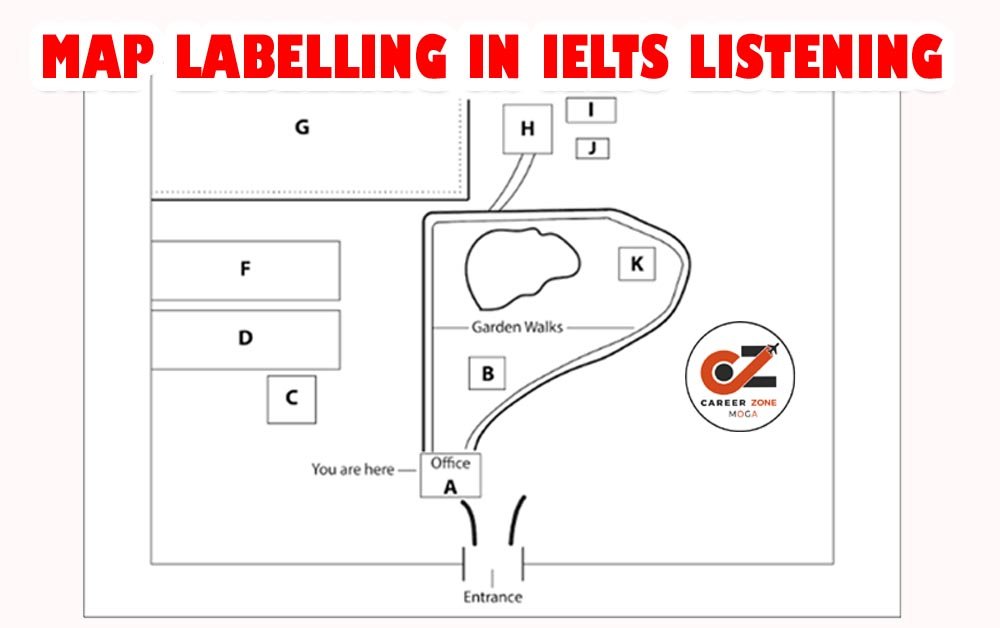
MAP LABELLING IN IELTS LISTENING
Map labeling is a common task in the IELTS Listening test that assesses your ability to understand and identify specific information in audio recordings. This task typically involves listening to a description of a place, such as a building, town, or park, and then labeling a provided map or diagram based on that information. Here are some effective strategies and tips to excel at map labeling in the IELTS Listening test.
1. Familiarize Yourself with Map Terminology
Before the test, familiarize yourself with common map terms and symbols. Understanding basic geographical terms like “north,” “south,” “east,” “west,” and terms related to buildings and structures (e.g., “restaurant,” “library,” “park”) will help you grasp the context quickly. You may also encounter terms like “intersection,” “avenue,” and “square,” which are crucial for understanding directions.
2. Practice with Sample Maps
Engage in practice exercises using sample maps. The official IELTS website and other preparatory materials provide practice tests that include map labeling tasks. This practice will help you become accustomed to interpreting maps and following spoken directions. Pay attention to how labels are applied and the relationship between different areas on the map.
MAP LABELLING IN IELTS LISTENING
3. Listen for Key Information
During the listening section, it’s essential to focus on key information that will help you label the map. This may include:
– Names of places: These could be landmarks, buildings, or streets mentioned in the audio.
– Descriptive words: Pay attention to adjectives or phrases that describe the location (e.g., “next to,” “opposite,” “behind”).
– Numbers and sequences: Sometimes, directions are given in steps, and understanding the order is crucial for correct labeling.
MAP LABELLING IN IELTS LISTENING
4. Use the Time Before the Recording Starts Wisely
Before the audio begins, you’ll have time to read the questions and examine the map. Use this time to familiarize yourself with the layout of the map. Identify any labels already provided and take note of the areas you think might be important. This pre-listening phase will help you anticipate what information you’ll need to listen for.
5. Note-Taking Strategies
While listening, jot down notes quickly. Write down keywords and phrases that stand out, especially those that indicate locations or directions. This will aid in recalling details later when you transfer your answers to the answer sheet. Keep your notes organized; for example, you might draw arrows or use different colors to represent directions.
MAP LABELLING IN IELTS LISTENING
6. Stay Focused on the Audio
It’s easy to lose track of the audio if you focus too much on writing. Concentrate on the speaker’s instructions and visualize the map in your mind. Try to follow the sequence of information being provided, as it often correlates with the layout of the map. If you miss something, don’t panic; keep listening for the next detail.
7. Anticipate Common Mistakes
Be aware of common pitfalls, such as mishearing similar-sounding words or confusing left with right. To minimize mistakes, listen for contextual clues that can confirm the information. For instance, if the speaker mentions a specific landmark, visualize where it is on the map to help solidify your understanding.
MAP LABELLING IN IELTS LISTENING
8. Review and Double-Check Your Answers
After the listening section, if time permits, go back and review your answers. Ensure that each label corresponds correctly to the information provided in the audio. Check for common errors, such as spelling mistakes or incorrect placements.
9. Practice with Real-Life Maps
Beyond IELTS materials, practice labeling real-life maps, such as city maps, transit maps, or tourist guides. This will enhance your ability to interpret various styles and layouts, making you more adaptable during the actual test.
Map labeling in the IELTS Listening test requires careful listening and effective note-taking. By familiarizing yourself with map terminology, practicing with sample maps, and employing effective listening strategies, you can improve your chances of success. Remember to stay calm and focused during the exam, and with practice, you’ll be well-prepared to tackle this task. Good luck!
MAP LABELLING IN IELTS LISTENING
